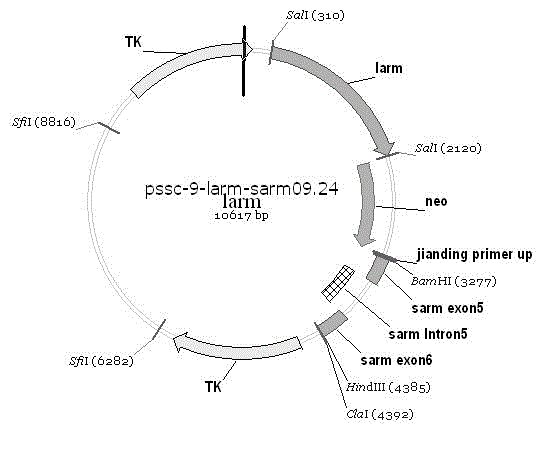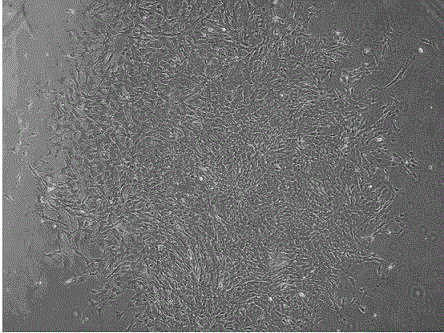Porcine reproductive and respiratory syndrome virus receptor CD163 knock-out swine and cultivation method thereof
A technology of respiratory syndrome and breeding method, applied in the field of porcine reproductive and respiratory syndrome virus receptor CD163 knockout pigs
- Summary
- Abstract
- Description
- Claims
- Application Information
AI Technical Summary
Problems solved by technology
Method used
Image
Examples
Embodiment 1
[0056] Construction of PRRSV Receptor CD163 Gene Knockout Vector
[0057] 1 Plasmid The important intermediate plasmids formed are pGM-T-Sarm-CD163 and pGM-T-Larm-CD163.
[0058]2 Experimental process Using the miniature pig genome as a template, the PCR method (see Table 2) was used to amplify the homologous left arm and right arm of the cloned pig CD163 respectively; -T were connected to construct pGM-T-Sarm-CD163 and pGM-T-Larm-CD163 respectively; pGM-T-Sarm-CD163 was digested with BamHI and hindIII, and the homologous right arm Sarm fragment of CD163 gene was recovered; Digest pGM-T-Larm-CD163, recover CD163 gene homologous left arm Larm fragment; CD163 gene homologous left arm and homologous right arm were respectively combined with positive selection gene Bip-Neo and negative selection gene HSV-t The targeting vector pSSC-9 was connected to construct a CD163 gene knockout vector containing positive and negative selection markers (see attached figure 1 ). The PCR pr...
Embodiment 2
[0066] Construction of porcine embryonic fibroblasts with CD163 gene knockout
[0067] 1 Plasmid pSSC-Larm-Sarm-CD163
[0068] 2-cell minipig embryonic fibroblasts
[0069] 3 Experimental process
[0070] 3.1 Vector linearization: extract pSSC-Larm-Sarm-CD163 plasmid, use Sfi I digestion, followed by ethanol precipitation, with sterile ddH 2 O dissolved.
[0071] 3.2 Cell transfection: The linearized vector was transfected into minipig fibroblasts according to the instructions of liposome Fugene HD (Invitrogen), and the cells were incubated in 5% CO 2 , cultured at 39°C.
[0072] The day before the transfection, the primary cultured embryonic fibroblasts were resuscitated into a 60mm dish with antibiotic-free culture medium, and the cells could be transfected when the cells reached 70-80% confluency. 24 h after transfection, the cells were passaged by trypsinization at 1:21. After 48 h of transfection, G418 selection medium (300 μg / ml concentration) was added. When...
Embodiment 3
[0090] Generation of gene knockout pigs by somatic cell nuclear transfer
[0091] 1 cell CD163 knockout porcine embryonic fibroblasts were constructed. the
[0092] 2 Animals Healthy Duroc sows (red), Landrace pigs (white).
[0093] 3. Experimental process Somatic cell nuclear transfer technology was used to construct CD163 gene knockout pigs.
[0094] 3.1 Collect pig ovaries from the slaughterhouse, place them in a thermos bottle containing double-antibody saline at 25-37 °C, and return them to the laboratory within 2 hours. The ovaries were washed several times with 37°C normal saline containing double antibodies, and the ovaries were placed in a 37°C water bath. Use a 20 mL syringe with a 18-gauge needle to aspirate 2-8 mm follicles on the ovary, and use a needle to pick out cumulus-oocytes with uniform cytoplasm and more than two layers of dense cumulus cells under a solid microscope. Cell complexes (COCs), after maturation in maturation medium, were removed by blind...
PUM
 Login to View More
Login to View More Abstract
Description
Claims
Application Information
 Login to View More
Login to View More - R&D
- Intellectual Property
- Life Sciences
- Materials
- Tech Scout
- Unparalleled Data Quality
- Higher Quality Content
- 60% Fewer Hallucinations
Browse by: Latest US Patents, China's latest patents, Technical Efficacy Thesaurus, Application Domain, Technology Topic, Popular Technical Reports.
© 2025 PatSnap. All rights reserved.Legal|Privacy policy|Modern Slavery Act Transparency Statement|Sitemap|About US| Contact US: help@patsnap.com



